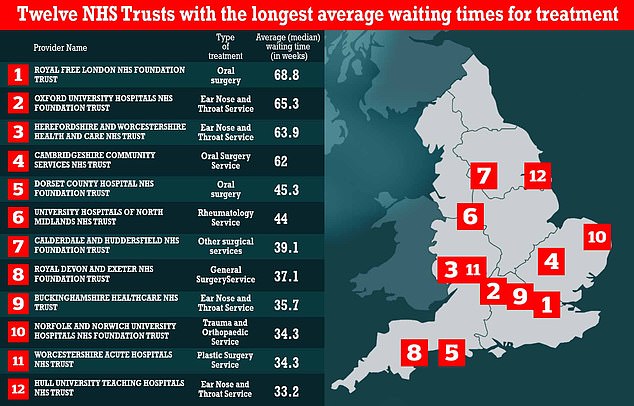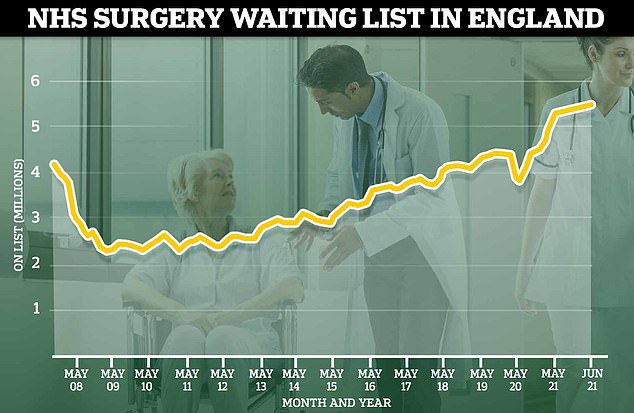More than 300,000 people in England have been left waiting more than a year for treatment on the NHS, analysis revealed today.
NHS England figures showed the biggest waits were for trauma and bone and muscle deformities, with 57,488 people waiting longer than 52 weeks.
A further 250,000 across all branches of medicine were left waiting beyond 18 weeks, the time by which the NHS aims to have seen every patient.
There are more than 83 trusts across the country where patients normally wait for longer than the target. Four of the top ten are in the South West.
The Labour party — which carried out the analysis — said the situation in England’s hospitals was ‘beyond urgent’.
It called on ministers to commit to a quarterly plan to bring down waiting lists.
Health workers unions warned the NHS is facing a crippling recruitment crisis with 75,000 doctors and nurses jobs already vacant.
Some 5.45million people were waiting to start routine hospital treatment at the end of June, according to the latest figures from NHS England — the highest number since records began in August 2007.
Waiting lists have spiralled during the pandemic because millions of treatments were cancelled as wards were turned over to Covid patients.

These are the 12 NHS hospitals with the longest waiting times in the country at one particular service. In the Labour party analysis, they split hospitals by waiting times for each of their services. This meant some hospitals were only considered once, as they only offered one service such as trauma, but others were looked at multiple times because they offered plastic surgery, trauma treatment and other services

Labour’s analysis split hospital waiting times by units such as trauma services, plastic surgery units and general surgery.
The longest waiting times were for oral surgery at the Royal Free London NHS Foundation Trust, with patients waiting 68.8 weeks to be seen on average.
Oxford University Hospitals Trust’s ear, nose and throat service had the second longest waiting time in England at 65.3 weeks.
And in Herefordshire and Worcestershire Health and Care NHS Trust, its ear, nose and throat service had the third longest waiting time at 63.9 weeks.
For comparison, only three units hit the NHS’ own target of seeing patients within 18 weeks. They were in Nottingham, Manchester and Birmingham.
England’s record-high NHS waiting list will only continue to rise, Sajid Javid has said
England’s record-high NHS waiting list will only continue to rise in the wake of the Covid crisis, the Health Secretary warned on August 12.
Sajid Javid said at least 7million people who ‘ordinarily would have come forward’ for medical treatment stayed away during the pandemic.
Health chiefs want those patients to ‘come back’ but accept it will cause a huge increase in demand that will cause waiting lists to rise.
Data released by NHS England on August 12 revealed 5.45million patients were waiting for routine treatment in June. It was the highest-ever figure since official records began in 2007.
Doctors also warned the backlog, exacerbated by the pandemic, could double in the next year.
This is despite the health service getting close to returning to pre-pandemic levels of activity, while juggling coronavirus pressures. Analysts say the mixture has left some hospitals are ‘busier than ever’.
Medics claim the NHS is ‘running on empty’ after 20 months of ‘unrelenting pressure’ and now faces ‘unprecedented’ demand for this time of year.
Advertisement
Shadow Health Secretary Jonathan Ashworth said: ‘Patients in every town and city are forced to endure lengthening waits for treatment in debilitating pain and facing anxiety at the risk of permanent disability.
‘Increasing numbers are forced to take out loans to go private while others have no option but to suffer ongoing agony and discomfort for months.
‘Ultimately, patients are paying the price for Tory failure to support the NHS and staff over the past decade — leaving the service understaffed, with beds cut and lacking the diagnostic equipment needed.’
He added: ‘The NHS is on its knees and will not cope unless ministers listen to staff and patients.
‘A credible long term NHS rescue plan to deliver quality care is now beyond urgent.
‘Patients in pain will be asking whether Boris Johnson’s promises on the NHS are meaningless.
‘Ministers must now take the action needed to prevent people becoming seriously ill, to deliver care on time, and return the NHS to the world class service it should be.’
Rachel Harrison, national officer at GMB, one of the country’s biggest trade unions, said: ‘After ten years of pay cuts and underfunding, morale among NHS staff is at rock bottom.
‘The health service faces a crippling recruitment and retention crisis, leading to 75,000 vacancies and huge waits for routine surgery.
‘GMB is calling for a restorative 15 per cent increase to make up for a decade of slashed pay under the Conservatives.
‘We have no hesitation in recommending members vote to reject the 3 per cent and no hesitation in supporting members if they want to take action.’
The next waiting list figures for England are due to be published on September 9.
Health Secretary Sajid Javid has warned the numbers will keep rising as people who stayed away during the worst of the pandemic return for treatment.
The number having to wait more than a year to start treatment was 304,803 in June — down from 336,733 the previous month but around six times the number from a year earlier.
NHS England already facing ‘winter-like’ pressures
The health service in England is experiencing ‘winter-like pressures’, the Society of Acute Medicine has warned.
Medics from the organisation, which represents doctors working in the field of acute medicine, said that doctors were treating ‘vast numbers’ of people with non-Covid illnesses as well as many attending hospital with severe coronavirus symptoms.
Dr Nick Scriven, immediate past president of the Society for Acute Medicine (SAM), said many patients were suffering from illnesses typically seen in winter such as respiratory infections – particularly in children, but also large numbers of patients who have seen their health deteriorate over the past 18 months.
The NHS is facing a huge backlog of care which has been exacerbated by the pandemic.
A record 5.45 million people are waiting for care in England alone.
‘I think it is fair to say we are currently facing an unprecedented summer workload that feels more like the worst winter pressures most of us can recall,’ said Dr Scriven.
‘We are seeing vast numbers of patients with non-Covid illness alongside the steady admission rates of those still very poorly with Covid.
‘The types of illnesses we are seeing are typical of winter weather as in a lot of respiratory infections, especially in paediatrics, but also a lot of people where the lack of access to primary and secondary care during the last 18 months could now be contributing to them needing hospital admission.
‘We are also noticing frailer people who have deconditioned over lockdowns so that any illness that previously might have been fairly minor now needs an extended stay in hospital with periods of rehabilitation.’
Dr Susan Crossland, president of SAM, said: ‘This is a deeply concerning time as we are in uncharted territory here with a summer crisis consisting of so many different problems with no end in sight and the daunting prospect of an extremely busy and difficult winter.
‘We know many hospitals are at bed occupancy levels well over the safe limit of 85%, with some at more than 95%, at this point of the year and we know we have worse to come with a system that just isn’t currently fit for purpose.’
Acute medicine deals with the immediate and early treatment of adult patients with a variety of medical conditions who present to hospital as emergencies
Advertisement
Modelling from the Institute for Fiscal Studies (IFS) earlier in August warned the NHS waiting list in England could rise to 14 million by autumn next year.
The Department of Health said: ‘Our NHS has overcome significant challenges throughout this global pandemic and wew will continue to support them to deliver the appointments, operations and treatment people need as quickly as possible.
‘We are already providing a record amount of funding to the NHS, with an extra £29billion this year alone to support health and care services, including £1billion to help tackle the backlog that has built up during the pandemic.’
It came as Scotland’s A&E waiting time performance has hit a record low for a third week running.
Performance against the four-hour waiting time target for A&E fell to 75.1 per cent for the week ending August 22.
In the previous week, 76 per cent of patients were admitted, transferred or discharged within the target time.
The figure also stood at 76 per cent in the week ending August 8.
The Scottish Government target is for 95 per cent of all A&E patients to wait no longer than four hours from arrival to admission, discharge or transfer.
This target has not been met since July 2020.
There were a total of 26,635 attendances in A&E units for the week ending August 22.
A total of 1,164 patients spent more than eight hours in an A&E department, while 268 spent more than 12 hours there.
Other statistics released by Public Health Scotland on Tuesday showed an increase in the number of patients waiting for key diagnostic tests such as endoscopy, a CT scan or an MRI scan.
This rose by 9.1 per cent between the end of March to the end of June to a total of 115,253 patients.
It means the total number of patients waiting for the key tests is 16.9% higher than the same time last year.
Responding to the diagnostic figures, David Ferguson, of Cancer Research UK, said: ‘It’s unacceptable that this target hasn’t been met for 11 years now and it’s clear action is long overdue.
‘Last week’s news that there’s to be new investment in diagnostic services is welcome.
‘A commitment to creating new radiographer training places will, in time, also be helpful.
‘But this is little comfort to patients who are on the waiting list now. They need reassurances that their symptoms will be investigated as a priority.
‘Those who are experiencing symptoms that could be cancer also need to have confidence that after visiting a GP their health concerns will be investigated in a timely manner.’
Health Secretary Huma Yousaf said the coronavirus pandemic has inevitably hit A&E departments, while the Scottish Government has recently offered £12 million to health boards for emergency care.
He said: ‘Scotland’s core A&E departments have outperformed those in the rest of the UK for more than six years.
‘Our NHS staff have faced unprecedented pressures over recent weeks.
‘They work tirelessly and consistently to respond to the pandemic whilst continuing to provide vital treatment and optimal patient care.
‘We are in daily contact with every board and are monitoring the situation closely.
‘Hospitals are reporting increased levels of people attending A&E who are much sicker and require higher levels of care.
‘Weekly performance is impacted due to a range of challenges including high attendances, staffing pressures due to isolation and annual leave and the continued requirement for infection control precautions that is affecting the time people need to spend in A&E.’
Source link : https://www.dailymail.co.uk/news/article-9943845/300-000-people-England-left-waiting-YEAR-routine-NHS-treatment.html











